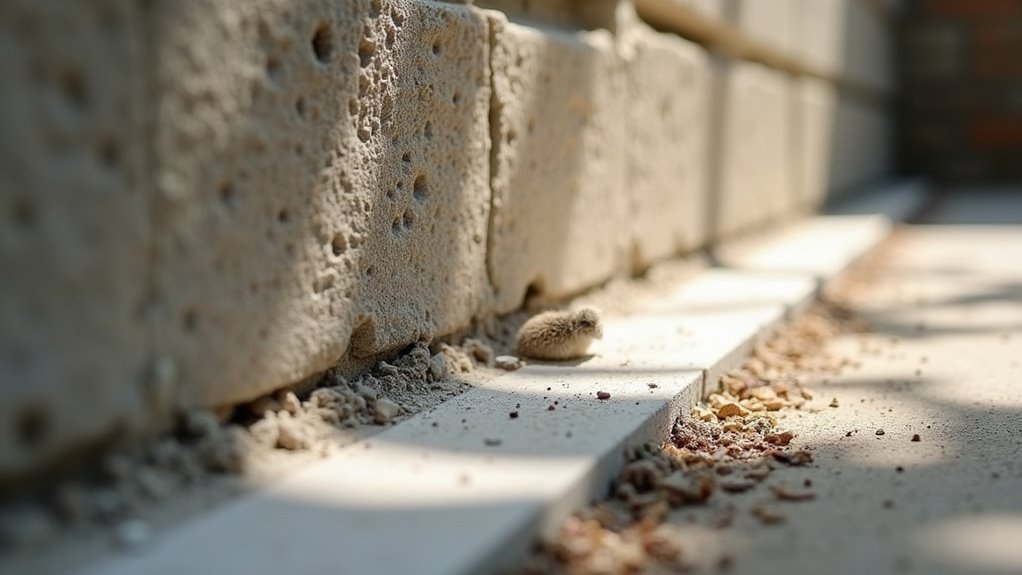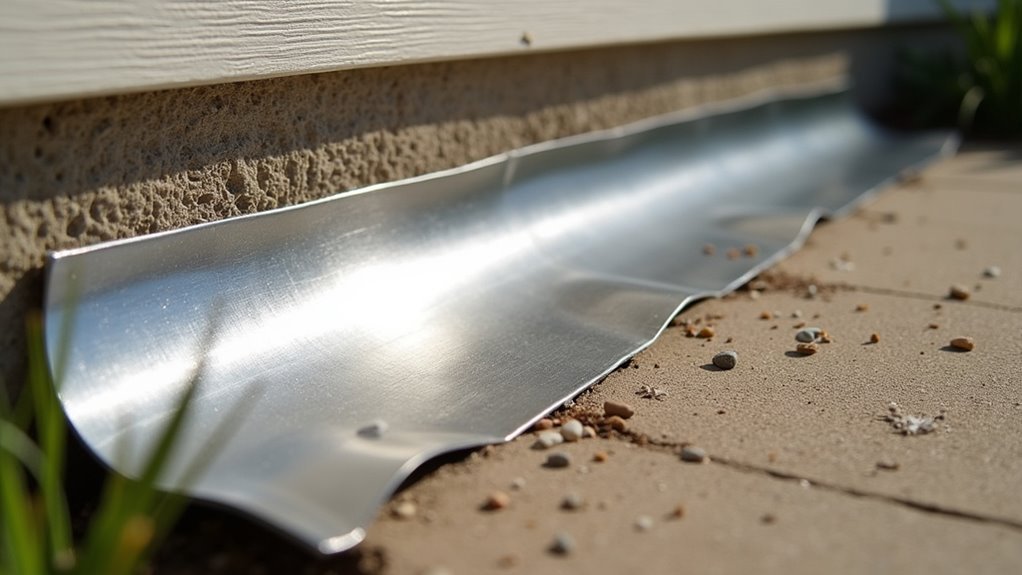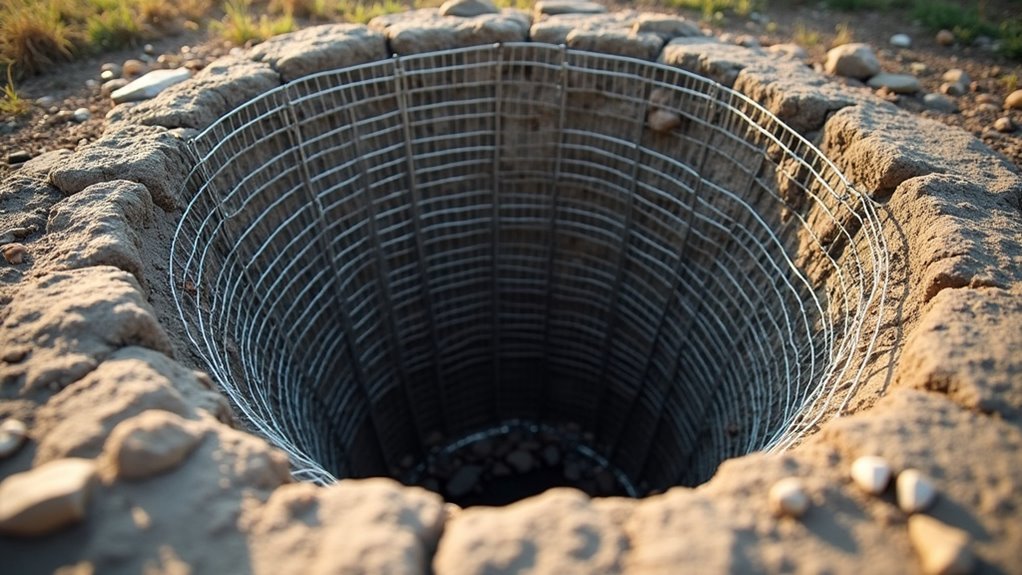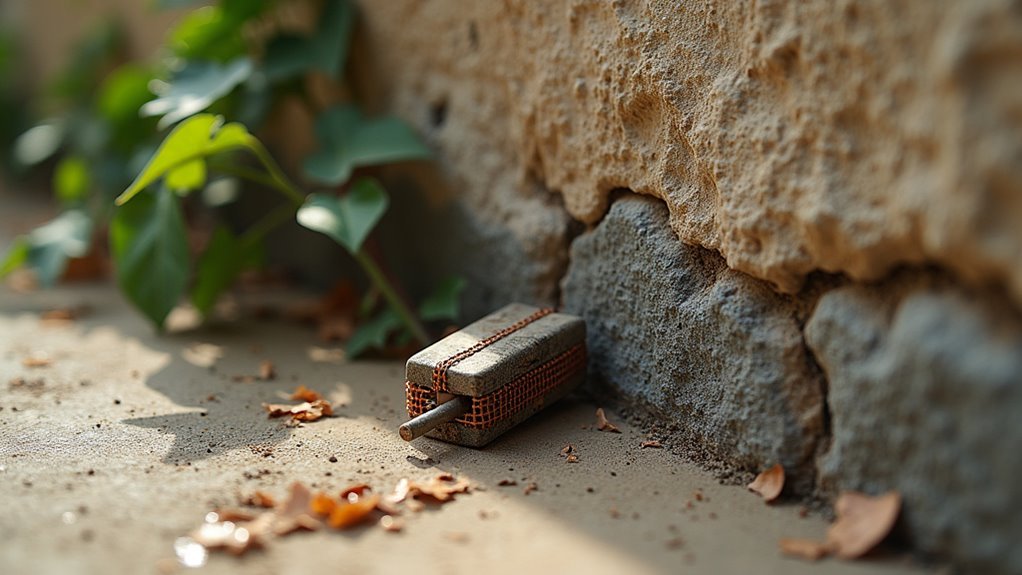You can mouse-proof your foundation by sealing gaps larger than 1/4 inch with steel wool and caulk, installing galvanized hardware cloth over larger holes, and applying metal flashing around the foundation base. Repair cracked mortar joints using tuck pointing, seal utility line penetrations with rodent-resistant expanding foam, and block access under porches with mesh barriers. Regular inspections guarantee your defenses remain effective against these persistent invaders who’ll exploit any weakness they discover.
Inspect Foundation Walls for Cracks and Gaps

Before you can effectively seal your foundation, you’ll need to thoroughly inspect your foundation walls for any cracks and gaps that could serve as entry points for mice.
Remember that rodents can squeeze through openings as small as 1/4 inch in diameter, so examine every detail carefully. Focus on deteriorating mortar between bricks or stones, as these create significant rodent entry opportunities.
Pay special attention to common entry points around doors and where utility lines penetrate your foundation. Use a flashlight to check high areas since mice are excellent climbers.
Don’t forget roof and attic access points. Schedule this inspection during late summer or early fall when cooler weather drives rodents indoors, making it vital to seal these openings promptly.
Seal Small Openings With Steel Wool and Caulk
Once you’ve identified cracks and gaps in your foundation walls, you’ll need the right materials to seal them effectively.
Steel wool works perfectly for gaps or openings larger than 1/4 inch since rodents can’t chew through it easily. Pack the steel wool tightly into these spaces, focusing on areas around utility lines, pipes, and foundation cracks where mice commonly enter.
Steel wool packed tightly into gaps larger than 1/4 inch creates an effective barrier that rodents cannot chew through.
After inserting the steel wool, apply caulk over it to create a complete seal. This combination provides excellent rodent control by eliminating entry points entirely.
Don’t forget to inspect these sealed areas regularly, as deterioration can create new vulnerabilities. If infestations persist despite your efforts, consider contacting professional pest control services for additional assessment and treatment options.
Apply Metal Flashing Around Foundation Base

You’ll need to install metal flashing correctly around your foundation’s base to create an effective barrier against rodents.
Secure the flashing firmly to your foundation using screws or nails, ensuring it extends at least 6 inches above ground level with no gaps for entry points.
Don’t forget to inspect your flashing regularly for damage and replace worn sections to maintain its protective effectiveness.
Proper Flashing Installation
Metal flashing creates an impenetrable barrier that rodents can’t chew through when properly installed around your foundation’s base. Secure the metal flashing so it extends at least 6 inches above ground level to block moisture and pest infiltration.
Overlap each piece by at least 2 inches to maintain a continuous barrier without gaps. Focus installation beneath garage doors, around vents, and where utility lines penetrate the foundation to seal potential entry points effectively.
These vulnerable spots often provide rodents easy access to your home’s interior spaces. Inspect your flashing regularly for damage or wear, as even tiny gaps compromise your defense system.
If you discover extensive rodent activity despite proper installation, contact professional pest control services for thorough assessment and treatment options.
Maintenance and Inspection
After installing metal flashing around your foundation base, establishing a regular maintenance schedule guarantees your rodent barrier remains effective over time.
You’ll need to inspect your metal flashing quarterly, checking for rust, dents, or corrosion that could compromise its integrity. Look carefully for any gaps where the flashing meets the foundation or where sections connect, as even small openings can lead to serious rodent problems.
Tighten loose screws and replace damaged sections immediately to maintain your barrier’s effectiveness. Don’t forget to clear debris that accumulates around the flashing base, which can create hiding spots or climbing aids for persistent pests.
Proper drainage inspection prevents moisture buildup that attracts rodents seeking shelter near your foundation.
Repair Mortar Joints in Stone and Brick Foundations
You’ll need to carefully examine your stone and brick foundation for cracked, crumbling, or missing mortar joints that create potential entry points for pests.
Start by identifying areas where the mortar has pulled away from the stones or bricks, appears powdery, or shows visible gaps.
Once you’ve located these deteriorated sections, you can begin the tuck pointing process to restore your foundation’s structural integrity and seal out unwanted rodents.
Identify Deteriorated Mortar Areas
Foundation mortar deteriorates over time, creating gaps that become highways for rodents seeking entry into your home.
You’ll need to carefully inspect your stone and brick foundations to spot these vulnerabilities before they become major problems.
Look for crumbling mortar that falls away when touched, missing chunks between bricks or stones, and hairline cracks that widen over time.
Pay attention to areas where mortar appears powdery, discolored, or markedly receded from the surface.
These deteriorated mortar joints provide easy rodent access points that mice and rats exploit.
Focus your inspection on ground-level areas where moisture damage is most common.
If you discover extensive damage, consider consulting professional pest control services who can recommend tuck pointing specialists to restore your foundation’s integrity.
Proper Tuck Pointing Technique
Remove deteriorated mortar from joints using a chisel and hammer or grout removal tool, digging at least one inch deep to guarantee proper adhesion for the new material.
Clean out all debris, dust, and loose particles before applying fresh mortar.
Use a pointing trowel to carefully work new mortar into the joints, ensuring complete coverage without gaps that rodents could exploit.
Match the color and texture of existing mortar for aesthetic consistency and effective sealing.
- Clean joints thoroughly to remove all old mortar and debris
- Apply new mortar using a pointing trowel for precise placement
- Match existing mortar color and texture for seamless appearance
- Seal all gaps completely to prevent rodent entry points
- Consider hiring a professional for extensive tuck pointing projects
Install Hardware Cloth Over Larger Foundation Holes

While expanding foam and caulk work well for smaller gaps, larger foundation holes require a more robust solution like hardware cloth. This galvanized steel mesh provides excellent rodent-proofing while maintaining proper ventilation around your foundation gaps.
Choose hardware cloth with mesh openings of 1/4 inch or smaller to prevent mice from squeezing through. Cut the material to fit snugly over each hole, extending it at least 6 inches beyond the opening’s edges. Secure it firmly with screws or heavy-duty staples to create an impenetrable barrier.
The galvanized coating resists rust and rodent gnawing, ensuring long-lasting protection. Inspect your hardware cloth installations regularly for signs of wear or damage, replacing compromised sections immediately to maintain effective rodent control around your foundation.
Waterproof Foundation While Mouse-Proofing
You’ll achieve the best results by selecting sealants that simultaneously block moisture and prevent rodent entry.
Choose waterproof sealants specifically formulated with rodent-resistant properties, as standard caulks won’t deter determined mice.
Pair these dual-purpose sealants with exclusion materials like copper mesh that won’t degrade when exposed to foundation moisture.
Dual-Purpose Sealant Selection
Finding the right sealant transforms your foundation work from a single-purpose task into an all-encompassing defense system.
You’ll need high-quality options that deliver both water resistance and rodent-proofing capabilities. Flexible polyurethane and silicone sealants excel at bonding to various surfaces while resisting chewing damage.
However, you can’t just grab any sealant off the shelf. You must confirm it’s specifically labeled as rodent-proof, since standard varieties won’t withstand determined gnawing.
These dual-purpose solutions create impenetrable barriers when properly applied to foundation gaps.
- Choose flexible polyurethane or silicone sealants for superior bonding
- Confirm rodent-proof labeling before purchasing any sealant
- Look for products that resist both moisture and chewing damage
- Verify compatibility with your specific foundation materials
- Prioritize durability for long-lasting protection
Moisture-Resistant Exclusion Materials
Beyond selecting the right sealant, you’ll want materials that tackle moisture and rodents simultaneously.
Moisture-resistant exclusion materials like high-quality sealants and waterproof membranes create dual protection by preventing water infiltration while blocking rodent entry points in foundation gaps.
Galvanized steel mesh works exceptionally well for sealing larger openings since it deters rodents and withstands moisture without rusting. This makes it perfect for wet environments where standard materials might fail.
While foam sealants effectively fill small gaps, they’re not rodent-proof alone and can degrade when exposed to moisture.
Always cover them with durable barriers for lasting protection.
Incorporate waterproofing techniques like tuck pointing deteriorated mortar to maintain foundation integrity while preventing rodent access.
Regular inspections guarantee your seals continue protecting against both moisture and unwanted pests.
Seal Utility Line Penetrations Through Foundation
Since utility lines must pass through your foundation to enter your home, these penetrations often create the most vulnerable entry points for mice and other rodents.
Foundation utility penetrations serve as superhighways for rodents seeking entry into your home’s warm interior spaces.
You’ll need to inspect these openings carefully and seal gaps around utility lines using proper materials and techniques.
Essential Steps for Sealing Utility Penetrations:
- Inspect thoroughly – Check all utility line entry points for gaps, cracks, or signs of rodent activity.
- Use steel mesh – Install galvanized steel or copper mesh around openings before applying sealants.
- Apply quality sealants – Use high-grade caulking or foam to create airtight seals around utility lines.
- Install protective covers – Add rodent-proof barriers over utility openings for extra protection.
- Schedule regular maintenance – Monitor sealed areas quarterly to maintain your rodent-free home or contact professional pest control services.
Block Access Under Porches and Deck Areas
While utility line penetrations represent the most common foundation vulnerabilities, porches and decks create equally problematic access points that require your immediate attention.
These structures often leave substantial gaps beneath them, providing perfect shelter for mice and other rodents seeking entry into your home.
You’ll need to seal openings using galvanized steel mesh or hardware cloth, materials specifically chosen because rodents can’t gnaw through them.
Fill larger voids with concrete to eliminate potential nesting sites and reinforce weak foundation areas.
Don’t overlook foundation vents during your inspection, as they’re frequent rodent entry points.
Install solid barriers or lattice around your porch and deck bases, and maintain debris-free surroundings.
For extensive infestations, consider professional pest control services.
Use Expanding Foam for Irregular Foundation Gaps
Although steel mesh and concrete work well for standard openings, irregular foundation gaps require a more adaptable solution. Expanding foam effectively fills these challenging spaces larger than 1/4 inch, creating a barrier against rodent entry while providing insulation benefits.
Expanding foam provides an adaptable solution for irregular foundation gaps, effectively blocking rodent entry while offering valuable insulation benefits.
Choose rodent-resistant expanding foam specifically designed to deter gnawing and chewing. Clean and dry the surface before application to guarantee peak adhesion and effectiveness.
Here are key steps for using expanding foam on irregular foundation gaps:
- Select rodent-resistant sealant designed to prevent chewing
- Clean surface thoroughly before applying foam
- Fill gaps larger than 1/4 inch completely
- Trim and paint cured foam for aesthetic appeal
- Inspect regularly for wear or damage requiring replacement
Regular maintenance guarantees your sealant maintains long-term effectiveness against pest intrusion.
Maintain Foundation Drainage to Prevent Settling Cracks
Water accumulation around your foundation creates the perfect conditions for soil erosion and settling cracks that compromise your home’s structural integrity. Proper foundation drainage prevents these issues while keeping mice from exploiting new entry points.
Maintain a slope directing water away from your foundation—at least 6 inches over 10 feet. Clean gutters and downspouts regularly to prevent overflow that saturates foundation areas.
| Drainage Method | Installation | Maintenance |
|---|---|---|
| Proper Grading | Shape soil slope | Annual inspection |
| French Drains | Professional setup | Clear debris yearly |
| Gutter Systems | DIY or contractor | Clean seasonally |
Monitoring soil moisture helps detect problems early. When settling cracks appear, they create new pathways for rodents. Consider professional pest control if drainage improvements don’t resolve existing mouse entry points through foundation gaps.
Frequently Asked Questions
How Do You Seal Gaps to Keep Mice Away?
You’ll seal gaps using galvanized steel mesh for openings over 1/4 inch and high-quality sealant for smaller cracks. Install door sweeps, apply weather stripping, and inspect your foundation thoroughly around utility lines.
How Do You Seal a Gap Between Siding and Foundation?
You’ll stuff galvanized steel mesh into gaps larger than 1/4 inch, then apply weatherproof caulk over it. Make certain your siding sits flush against the foundation and regularly inspect for damage or wear.
What Is the Best Sealant for Mouse Holes?
You’ll want high-quality silicone or polyurethane sealants for mouse holes since they’re chew-resistant and provide strong adhesion. For larger gaps, combine expanding foam with steel wool or copper mesh for maximum effectiveness.
How Do I Stop Mice From Digging Under My Foundation?
Seal foundation cracks with steel wool or concrete, install metal mesh barriers, clear debris from around your home’s perimeter, add door sweeps, and use peppermint oil repellent to deter mice effectively.
In Summary
You’ve now got the tools to effectively mouse-proof your foundation. Don’t wait until you spot the first rodent – start inspecting and sealing those gaps today. Remember, mice can squeeze through openings as small as a dime, so thoroughness is key. Regular maintenance of these seals will keep your home rodent-free year-round. Take action now, and you’ll save yourself from costly pest control bills later.





Leave a Reply